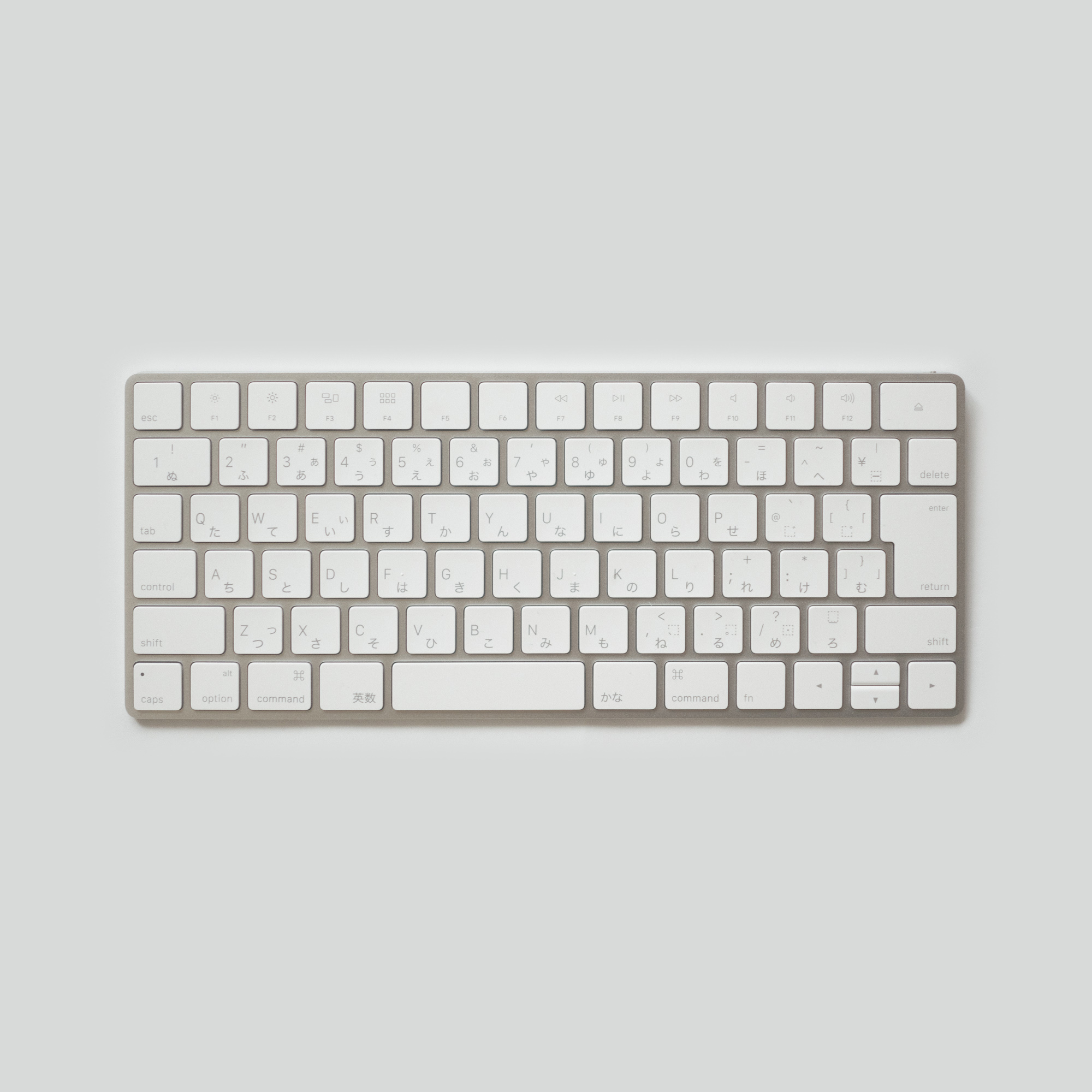Similar in overall dimensions to the previous-generation, confusingly identically-named wireless Magic Keyboard - the new Apple Magic Keyboard ($99USD/ ¥11,800JPY) brings to the table a built-battery, lightning cable charging/pairing and most importantly or decisively - a different key feel via an updated scissor key mechanism.
This new key feel - shallower and in some ways similar to the keyboard introduced in the ultraslim 12" Macbook - was one that ended up feeling really, really good to us when we tested it out in the store (the same place we got this) and we ended up making the purchase on impulse.
After a few days of use, we can safely say that we prefer it to the previous generation model - despite the shallower key travel there is a nice resiliency to each keystroke, finished by a satisfyingly firm stop at the bottom and a pleasing flat strike sound with each press that echoes a sort of muted, distilled integration of the old mechanical keyboards of yesteryear.
Physically speaking, the keyboard is flatter and much lower profile than the previous generation - it is both slight and light enough to throw into a bag and almost forget and with its appealing white and aluminium design we’ve found ourselves eying it as a replacement for our iPad Pro keyboard cover… aesthetically it matches so much better than the ugly gray silicon and it may actually even be lighter in weight.
Additionally, some of the keys are differently sized than the previous model. Fn keys are now full sized as are the L/R arrow keys. For us, these changes made no difference in everyday use, but for some who are accustomed to differences in the arrow key sizes it might be off-putting - personally we like how the new keyboard fills the entirety of its surface with keys and no wasted space.
The most noticeable physical change is the switch from replaceable AA batteries to a built-in rechargeable battery, which is responsible for the bulk of the weight savings and the new refined slimmer profile. The keyboard itself charges via a lightning cable, which is included as a pack in - it’s always nice to get an extra lightening cable, which are not cheap to buy on their own.
Working out the actual recharge/use time is less than clear - when we asked at the Apple store we received the confusing reply 「2時間で1ヶ月」(“2 hours for 1 month”) which we finally came to understand as “2 hours of charging yields approximately 1 months worth of usage” - since there are no qualifiers around what constitutes “1 months worth of usage” (is that constant typing? With the power turned off when not using it? How many hours of typing per day? Weekdays and weekends? etc.) we say only this - we plugged it in overnight (definitely overkill but its simpler that way) and have been using it approximately 4~6 hours a day for a week straight and still have 89% power left)
Besides charging the battery, the lightning cable also has one other neat trick in that connecting the keyboard to the computer via the cable also instantly pairs it. In practise we found this to be quite unnecessary as the keyboard pairs instantly with the host computer over bluetooth - the previous model could be quite finicky about pairing, particularly when switching between computers or replacing the batteries.
When we bought this keyboard we were torn between purchasing the accompanying Magic Trackpad 2 or the Magic Mouse 2. The trackpad definitely has more physical changes than the mouse versus the previous generation, but being heavy mouse users and only begrudging trackpad users when we have no choice, we opted for the mouse (which we will review separately).
That having been said, now that the keyboard sits on our desk, we find its slim profile and refine shape to almost beg for the accompanying trackpad… perhaps one of these days, we suppose.
In conclusion, it’s hard to recommend this as a must have upgrade for existing users of the current generation keyboard unless one has a strong preference for the updated key feel as we did. Honestly speaking whilst the update design and rechargeable battery are nice features, in everyday life they probably do not matter enough to justify the $99USD/ ¥11,800JPY asking price. Considering the primary function of a keyboard however, the updated key switches and profiles may in fact be a compelling enough reason to make the switch, as may iPad/iPad Pro users looking for an alternative to the sufficiently functional, but ugly, official iPad Pro keyboard cover or third party alternatives.
Note: We are reviewing the JIS (Japanese layout) model of this keyboard. With the exception of the key layout it is identical to the US version. You can see an image of the Japanese Layout and the US Layout on the Apple site.


